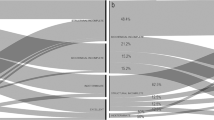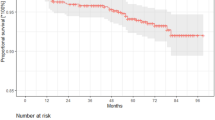Abstract
Objective
The aim of this study was to investigate if increased serum thyroglobulin (Tg) levels after radioactive iodine (RAI) showed more therapeutic effects in patients with differentiated thyroid cancer (DTC).
Methods
Data of 65 patients with DTC who underwent RAI from June 2014 to September 2016 were reviewed. Serum thyroglobulin was measured immediately before (Tg1) and 48 h (Tg2) after RAI under TSH stimulation. Differences and ratios between serum Tg measurements (DeltaTg = Tg2 − Tg1 and RatioTg = Tg2/Tg1) were calculated. The treatment response of distant metastasis was assessed using the RECIST criteria.
Results
There was no difference in the median values of Tg1 and Tg2 (2.6 [range, 0.7–1957.5] ng/mL vs. 7.4 [range, 0.7–5276.0] ng/mL, p = 0.240) in all patients (73 scans, 65 patients). In subgroup analysis, Tg levels increased slightly in patients with distant metastasis (8 scans, 7 patients) (Tg1 vs. Tg2; 48.9 [range, 2.4–1957.5] ng/mL vs. 63.2 [range, 4.4–5276.0] ng/mL, p = 0.408). Among patients with distant metastasis, one patient with a partial response to treatment had a more than 4000fold increase in Tg levels and one patient with stable disease showed a 20fold increase in Tg levels. In contrast, five patients with disease progression showed only two to eightfold increase or more than 100fold decrease in Tg levels at 48 h after RAI. However, there was a significant increase in serum Tg levels in patients without distant metastasis (65 scans, 58 patients) after RAI (Tg1 vs. Tg2; 2.0 [range, 0.7–141.9] ng/mL vs. 6.8 [range, 0.7–577.7] ng/mL, p = 0.026).
Conclusions
A higher elevation of Tg levels after RAI may be associated with a better treatment outcome in DTC patients with distant metastasis. An increase in Tg levels after RAI may reflect the destruction of cancer and thyroid cells.




Similar content being viewed by others

References
Lang BH, Wong KP, Cheung CY, Wan KY, Lo CY. Evaluating the prognostic factors associated with cancer-specific survival of differentiated thyroid carcinoma presenting with distant metastasis. Ann Surg Oncol. 2013;20(4):1329–35.
Mazzaferri EL, Kloos RT. Clinical review 128: Current approaches to primary therapy for papillary and follicular thyroid cancer. J Clin Endocrinol Metab. 2001;86(4):1447–63.
Webb RC, Howard RS, Stojadinovic A, Gaitonde DY, Wallace MK, Ahmed J, et al. The utility of serum thyroglobulin measurement at the time of remnant ablation for predicting disease-free status in patients with differentiated thyroid cancer: a meta-analysis involving 3947 patients. J Clin Endocrinol Metab. 2012;97(8):2754–63.
Toubeau M, Touzery C, Arveux P, Chaplain G, Vaillant G, Berriolo A, et al. Predictive value for disease progression of serum thyroglobulin levels measured in the postoperative period and after (131) I ablation therapy in patients with differentiated thyroid cancer. J Nucl Med. 2004;45(6):988–94.
Giovanella L, Suriano S, Ceriani L, Verburg FA. Undetectable thyroglobulin in patients with differentiated thyroid carcinoma and residual radioiodine uptake on a postablation whole-body scan. Clin Nucl Med. 2011;36(2):109–12.
Bernier MO, Morel O, Rodien P, Muratet JP, Giraud P, Rohmer V, et al. Prognostic value of an increase in the serum thyroglobulin level at the time of the first ablative radioiodine treatment in patients with differentiated thyroid cancer. Eur J Nucl Med Mol Imaging. 2005;32(12):1418–21.
Kim YI, Im HJ, Paeng JC, Cheon GJ, Kang KW, Lee DS, et al. Serum thyroglobulin level after radioiodine therapy (day 3) to predict successful ablation of thyroid reminant in postoperative thyroid cancer. Ann Nucl Med. 2015;29(2):184–9.
Muratet JP, Giraud P, Daver A, Minier JF, Gamelin E, Larra F. Predicting the efficacy of first iodine-131 treatment in differentiated thyroid carcinoma. J Nucl Med. 1997;38(9):1362–8.
Lee J, Soh EY. Differentiated thyroid carcinoma presenting with distant metastasis at initial diagnosis clinical outcomes and prognostic factors. Ann Surg. 2010;251(1):114–9.
Schlumberger M, Challeton C, De Vathaire F, Travagli JP, Gardet P, Lumbroso JD, et al. Radioactive iodine treatment and external radiotherapy for lung and bone metastases from thyroid carcinoma. J Nucl Med. 1996;37(4):598–605.
Maxon HR, Smith HS. Radioiodine-131 in the diagnosis and treatment of metastatic well differentiated thyroid cancer. Endocrinol Metab Clin North Am. 1990;19(3):685–718.
Choi JH, Moon H, Park J, Chang K, Byun BH, Lim I, et al. Long-term outcomes of differentiated thyroid cancer with bone metastasis and the prognostic factors. J Nucl Med. 2015;56(supplement 3):1224.
Choi JH, Moon H, Park J, Chang K, Byun BH, Lim I, et al. Long-term outcomes of differentiated thyroid cancer with only lung metastasis and the prognostic factors. J Nucl Med. 2015;56(supplement 3):1260.
Eisenhauer EA, Therasse P, Bogaerts J, Schwartz LH, Sargent D, Ford R, et al. New response evaluation criteria in solid tumours: revised RECIST guideline (version 1.1). Eur J Cancer. 2009;45(2):228–47.
Casara D, Rubello D, Saladini G, Masarotto G, Favero A, Girelli ME, et al. Different features of pulmonary metastases in differentiated thyroid cancer: natural history and multivariate statistical analysis of prognostic variables. J Nucl Med. 1993;34(10):1626–31.
Mihailovic J, Stefanovic L, Malesevic M, Markoski B. The importance of age over radioiodine avidity as a prognostic factor in differentiated thyroid carcinoma with distant metastases. Thyroid. 2009;19(3):227–32.
Sampson E, Brierley JD, Le LW, Rotstein L, Tsang RW. Clinical management and outcome of papillary and follicular (differentiated) thyroid cancer presenting with distant metastasis at diagnosis. Cancer. 2007;110(7):1451–6.
Ramakrishnan N, McClain DE, Catravas GN. Membranes as sensitive targets in thymocyte apoptosis. Int J Radiat Biol. 1993;63(6):693–701.
Nishiyama K, Kozuka T, Higashihara T, Miyauchi K, Okagawa K. Acute radiation thyroiditis. Int J Radiat Oncol Biol Phys. 1996;36(5):1221–4.
Stevic I, Dembinski TC, Pathak KA, Leslie WD. Transient early increase in thyroglobulin levels post-radioiodine ablation in patients with differentiated thyroid cancer. Clin Biochem. 2015;48(10–11):658–61.
Hocevar M, Auersperg M, Stanovnik L. The dynamics of serum thyroglobulin elimination from the body after thyroid surgery. Eur J Surg Oncol. 1997;23(3):208–10.
Lang BHH, Woo YC, Chiu KWH. The percentage of serum thyroglobulin rise in the first-week did not predict the eventual success of high-intensity focussed ablation (HIFU) for benign thyroid nodules. Int J Hyperth. 2017;33(8):882–7.
Rosario PW, Maia FF, Cardoso LD, Barroso A, Rezende L, Padrao EL, et al. Correlation between cervical uptake and results of postsurgical radioiodine ablation in patients with thyroid carcinoma. Clin Nucl Med. 2004;29(6):358–61.
Rosario PW, Reis JS, Barroso AL, Rezende LL, Padrao EL, Fagundes TA. Efficacy of low and high 131I doses for thyroid remnant ablation in patients with differentiated thyroid carcinoma based on post-operative cervical uptake. Nucl Med Commun. 2004;25(11):1077–81.
Beierwaltes WH, Rabbani R, Dmuchowski C, Lloyd RV, Eyre P, Mallette S. An analysis of “ablation of thyroid remnants” with I-131 in 511 patients from 1947 to 1984: experience at University of Michigan. J Nucl Med. 1984;25(12):1287–93.
Author information
Authors and Affiliations
Corresponding author
Rights and permissions
About this article
Cite this article
Choi, J.H., Lim, I., Lee, I. et al. An enhanced treatment effect can be expected from a higher serum thyroglobulin level after radioactive iodine therapy. Ann Nucl Med 33, 128–134 (2019). https://doi.org/10.1007/s12149-018-1313-5
Received:
Accepted:
Published:
Issue Date:
DOI: https://doi.org/10.1007/s12149-018-1313-5



